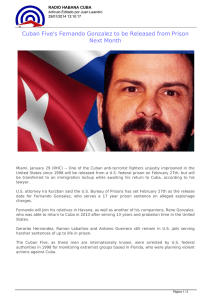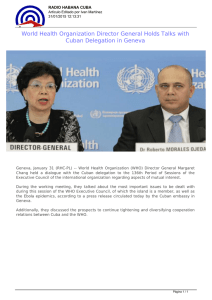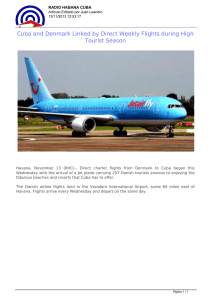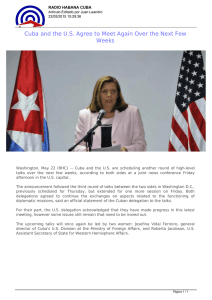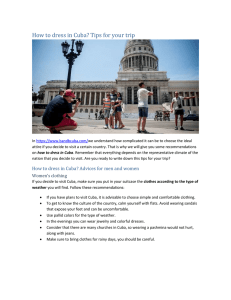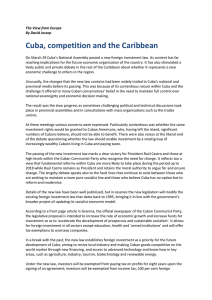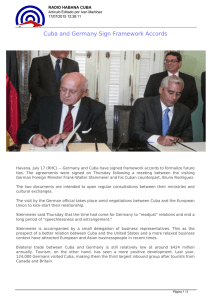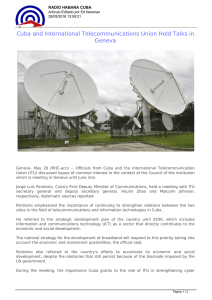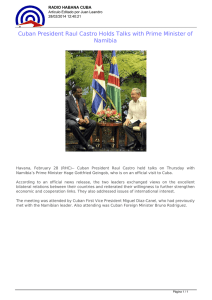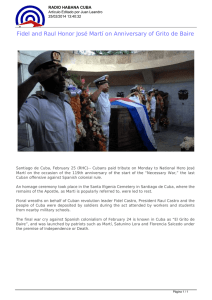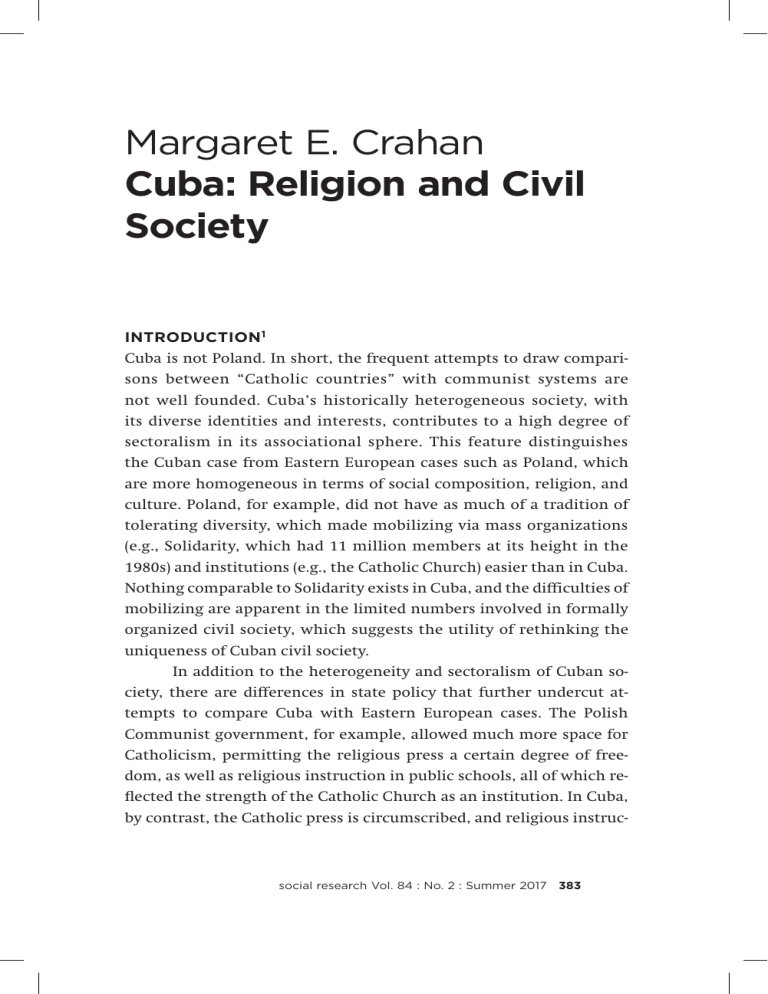
Margaret E. Crahan Cuba: Religion and Civil Society INTRODUCTION1 Cuba is not Poland. In short, the frequent attempts to draw comparisons between “Catholic countries” with communist systems are not well founded. Cuba’s historically heterogeneous society, with its diverse identities and interests, contributes to a high degree of sectoralism in its associational sphere. This feature distinguishes the Cuban case from Eastern European cases such as Poland, which are more homogeneous in terms of social composition, religion, and culture. Poland, for example, did not have as much of a tradition of tolerating diversity, which made mobilizing via mass organizations (e.g., Solidarity, which had 11 million members at its height in the 1980s) and institutions (e.g., the Catholic Church) easier than in Cuba. Nothing comparable to Solidarity exists in Cuba, and the difficulties of mobilizing are apparent in the limited numbers involved in formally organized civil society, which suggests the utility of rethinking the uniqueness of Cuban civil society. In addition to the heterogeneity and sectoralism of Cuban society, there are differences in state policy that further undercut attempts to compare Cuba with Eastern European cases. The Polish Communist government, for example, allowed much more space for Catholicism, permitting the religious press a certain degree of freedom, as well as religious instruction in public schools, all of which reflected the strength of the Catholic Church as an institution. In Cuba, by contrast, the Catholic press is circumscribed, and religious instruc- social research Vol. 84 : No. 2 : Summer 2017 383 tion in the state educational system is prohibited. Religious media and instruction are two of the most effective mechanisms for maintaining an informed and loyal laity that is inclined to be mobilized. The historical heterogeneity of the Cuban religious scene, and traditionally low institutional loyalty, have resulted in the Cuban Catholic Church not having the same capacity to mobilize around a consensual national agenda or leadership; nor has the Catholic Church in Cuba served as an institutional base for the opposition to the government as it did in Poland and in other authoritarian countries such as Brazil and Chile in the 1970s and 1980s. In short, such comparisons confirm that the Cuban case is unique in that the country is a nation of believers but religion is not a major factor in uniting and mobilizing civil society. Nevertheless, as political space has increased on the island, particularly since the 1990s, religions have increasingly asserted themselves, especially given the weakness of civil-society organizations. Approximately two-thirds of Cubans have traditionally identified themselves as Catholics, and at least as many claim to practice Spiritism, highlighting the degree of syncretism that exists in Cuba. To add to the confusion, many Cuban Catholics both before and after 1959 never entered a church or had contact with a priest. Nevertheless, Cubans, including both Fidel and Raúl Castro, appear to identify religion with the institutional Catholic Church (Castro 1990). In the case of Raúl Castro, since his emergence as head of state in 2008, he has involved the Catholic Church leadership in negotiations for the release of political prisoners and with the human rights group Ladies in White,2 as well as initiated regular contact with the cardinal of Havana, to the consternation of some Catholics. Both Castros, when considering outreach to religions, appear most comfortable with the hierarchically structured Catholic Church. Many nonpracticing Cubans identify their country as Catholic, particularly in terms of social mores and identifiers of cubanidad.3 For example, the Virgen de Caridad de Cobre (Ochún in Spiritism) is regarded as a national symbol, and in 2010–11 thousands of Cubans 384 social research turned out to welcome the sixteenth-century statue of the Virgin as it made its way from the eastern to the western part of the island. Catholicism and Spiritism both emphasize family and community and are frequently given expression through popular religiosity rather than institutional involvement (Crahan 2003). Sectoralism in Cuba is encouraged by historical divisions rooted in ethnic, geographic, and socioeconomic cleavages. Afro-Cubans, for example, have used Spiritist-based religions to organize resistance to exploitation and demand their rights as far back as the earliest importation of Africans as slaves. In the late eighteenth and nineteenth centuries, when the number of Cubans of African descent increased to more than half the population, Afro-Cuban religious beliefs served to unite them in their struggle for basic political and socioeconomic rights. The most pervasive networks in Cuba today are identified with the Spiritists and the institutional Catholic Church. Both have increased their social welfare activities, particularly since the economic crisis of the early 1990s. Spiritist communities have responded to local needs by emphasizing primarily grassroots organization to compensate for the limitations of the state in providing social services. Catholic, Protestant, and Jewish groups have reacted by providing food and medical supplies through their institutions in cooperation with the government, often paid for by foreign donations. Different approaches have contributed to a degree to ongoing sectoralism and limited ecumenical cooperation, with the Spiritist groups identified largely with the poorer AfroCuban communities and the rural population. Cooperative efforts by religions in Cuba to build a consensual national socioeconomic and political agenda and leadership are limited. Nonreligious actors, including old and new NGOs, are also expanding their influence as the availability of state services declines. Finally, political parties are reappearing in Cuba, in part as a result of resources provided by the Christian Democratic, Social Democratic, and Liberal Internationals. However, the most widespread networks continue to be those that are religiously based. Cuba: Religion and Civil Society 385 CIVIL SOCIETY AND RELIGION IN CUBA Much of the literature on Cuba has concluded that one of the prime reasons for the triumph of the revolutionary 26th of July Movement in 1959, and the subsequent consolidation of a Marxist-Leninist government, was the weakness of civil society and religion. Such assertions are without a strong basis. Civic and other organizations were common in Cuba as early as the nineteenth century, and they continued to proliferate throughout the twentieth century. By 1959, Cuban civil society had developed into one of the most advanced in Latin America in spite of periodic prerevolutionary government attempts to regulate it both legally and through repression (Quiroz 2003). The tendency for religions to be regarded as relatively weak in Cuba flows essentially from a focus on institutional attributes such as formal participation, levels of activism, and direct political influence. It is true that attendance at services and participation in religious groups were historically relatively low in Cuba and political influence was somewhat weak, as compared to other Latin American countries. However, the vast majority of Cubans were believers in the divine, normative religious values were prevalent, and popular religiosity was widespread. At the same time, the very multiplicity of religions and the weak presence of religious institutions, especially in rural areas, contributed to low levels of practice and a high level of syncretism and permeability in terms of both religious and secular belief systems.4 Cuba’s religious evolution has been heavily determined by its history as a commercial entrepôt and sugar colony, and later as a republic with relatively loose immigration regulations. The ongoing encounters of indigenes, Europeans, Africans, Chinese, Jews, and North Americans, among others, resulted in an intense process of interchange, adaptation, borrowing, and overlapping, as well as the abandonment of some beliefs and practices in favor of the construction of more syncretic ones. All religions in Cuba have been characterized by a high degree of flexibility and permeability, and civil society shares those characteristics to a degree. 386 social research This is clearly reflected in the image of Cuba’s patron saint, the Catholic Virgen de La Caridad de Cobre, whose statue was “found” floating in the Bay of Nipe in 1613. The statue stands poised on a half circle, the indigenous sign for the moon, and is associated with life, growth, fertility, solace, and caring for the poor, as is the Afro-Cuban spirit Ochún, with whom she is identified. Soldiers going into battle during the Cuban wars of independence (1868–78, 1895–98) carried her image, as did some of those same troops who subsequently participated in the 1912 insurrection to oppose racial discrimination and gain more jobs for Afro-Cubans in the public and private sectors (Portuondo 1995; Helg 1995). Throughout the twentieth century, the Virgin was identified largely with the working class, although few middle- and upper-class homes were without her image. In the 1950s both pro- and anti-Batista forces appealed to La Caridad, while Fidel and Raúl Castro’s mother reportedly affixed ex-votos to the Virgin’s altar in Cobre to protect her sons during the guerilla struggle that brought them to power in 1959. To commemorate that triumph, a mass of thanksgiving was said in La Caridad’s sanctuary in Oriente Province (Portuondo 1995). That same year the statue was transported to Havana for the National Catholic Congress, which was attended by an estimated 1 million Cubans, including Fidel, at which shouts of “Cuba sí, comunismo no” rang out (Julien and Cuneen 1961; Padula 1974). La Caridad did not return to Havana until 2011, when the government allowed public processions in her honor as part of efforts to demonstrate its openness to religious expression. Devotion to La Caridad cuts across not only ethnic and class divisions in Cuba but also the fragmentation of Cubans within and outside the island. In the midst of the debate in Miami over whether to travel to Cuba for the 1998 visit of Pope John Paul II, Miami Bishop Agustín Román called for unity because, as he phrased it, Cubans “are not divided, because we all love the virgin” (Pique 1997, 4B). In 2015 Pope Francis visited the Sanctuary of La Caridad and emphasized her role in uniting Cubans both within and without the island. The wide- Cuba: Religion and Civil Society 387 spread devotion to the Virgen de La Caridad de Cobre and her role as the prime symbol of national identity illustrate the degree to which popular religiosity and syncretic beliefs are prevalent among Cubans, even if traditional indicators of formal religious participation are low (Crahan 2003). Therefore, Cuba is somewhat contradictory in that while it is a nation of believers, institutional religion, especially Catholicism, has been weaker than in most of Latin America’s formerly Spanish colonies, thereby giving rise to the notion that religion in general has enjoyed relatively little sway in Cuba. This is also due to the fact that during the colonial period, the relative isolation of Cuba encouraged a greater degree of autonomy and adaptive response to local conditions on the part of both the Catholic clergy and the laity than in the mainland Spanish possessions. There developed considerable religious heterodoxy, including in the Catholic Church, which had within it a strain of independent thinkers who in the early nineteenth century began championing independence from Spain, the abolition of slavery, a republican form of government, and expanded citizens’ rights. One result was Spain’s cracking down on individuals and groups regarded as subversive. Chief among them was Father Félix Varela y Morales (1787–1853), a professor at the Seminary of San Carlos and San Ambrosio in Havana, who was exiled in 1823 to the United States. Varela was one of the first to champion individual rights and the reform of Cuban political, economic, religious, and social structures according to the needs of the citizenry. His writings provided one of the earliest elaborations of a liberal polity and civil society (Torres Cuevas 1997; Varela 1977; Liss 1987). Varela’s ideas influenced the independence leader José Martí and were adduced as recently as 1997 at a University of Havana colloquium as suggesting how a just society should be organized (Torres Cuevas et al. 1999). In general, however, Catholic priests varied widely in terms of their religious and political attitudes, as well as their political behavior, as did other religious leaders—including those involved in indigenous or Afro-Cuban religions (Ayorinde 2004; Crahan 2003; Maza 388 social research 1990, 1993). Most reflected the belief systems of the communities they inhabited, where daily concerns mingled with religion to mold values and behavior. Overall, the Catholic Church as an institution was identified with Spanish colonial control and, after independence, with authoritarian governments (Kirk 1989, 20–22). The influx of Protestant missionaries from the US in the early twentieth century reduced the influence of the Catholic Church and served to further increase the diversity of Cuban society. Institutional religion tended to be identified with urban middle and upper classes, while the rural and urban poor were more involved in Spiritism. Beginning in the 1940s, Pentecostalism grew among the lower and middle classes. Such cleavages contributed further to the institutional weakness of the Cuban Catholic Church in a nominally Catholic country. Protestant ministers and laypersons were effective transmitters of liberal political ideas. Some Protestant ministers, like their Catholic counterparts, fell afoul of the colonial administration and were forced into exile, generally in the United States, where their ideas concerning citizen participation and rights were further developed. Be it abroad or on the island, many of them contributed to the movement for independence (Crahan 1982, 2003; Ramos 1989; Yaremko 2000). The level of civil society organization immediately prior to the 1895–98 war of independence was notable, and some religious leaders were active not only in legitimizing the independence movement but also as combatants. In the early twentieth century, Protestant schools proliferated and appealed particularly to the Cuban middle classes, which increasingly were composed of immigrants from Europe who harbored diverse political and religious ideas. A good number of graduates of Protestant schools emerged in the mid-twentieth century as economic and political leaders, with some bankrolling the 26th of July Movement and serving in the Castro government. Some continue to serve in the government while others opted to leave Cuba, at times utilizing the networks they acquired in Protestant congregations and schools. Cuba: Religion and Civil Society 389 Sectors of the revolutionary movements of the 1930s and 1950s used religious beliefs and networks not only to legitimate their objectives but also to mobilize resources and collaborators. Protestant and Catholic university students were active in both movements, while some church groups and leaders served to generate resources for the efforts. Reformist movements, including Catholic Action (Acción Católica) and the Catholic Association (Agrupación Católica), grew particularly in the 1950s.5 In short, while formal church attendance in Cuba throughout the twentieth century may have been low, religious beliefs and generalized identification with religious norms were common and, at times, coexisted with interest in socialism. The latter was stimulated by interpretations of the social doctrines of the Catholic Church, which increasingly emphasized socioeconomic justice and, in particular, workers’ rights. Some mainline Protestants, such as the Presbyterians, Baptists, and Methodists, also promoted socioeconomic reforms and supported political change. This helped justify movements in support of the end of the Batista regime or at least less governmental corruption and abuse of power. Hence, while the percentage of Cubans actually engaging in regular religious practice was not high, religiously informed beliefs were historically widely held and influenced concepts of polity and society, as well as Cubans’ involvement in civil society and politics.6 Furthermore, the level of belief in the divine has remained remarkably stable in Cuba from the 1950s to the present (approximately 75 percent to 85 percent), albeit formal religious practice remains low.7 The consolidation of a Marxist-Leninist regime in the 1960s marginalized institutional religions whose historical weaknesses facilitated such consolidation, particularly given the departure of the majority of the Catholic and Protestant clergy, as well as a good number of church activists. Emigration of civil society leaders in the first half of the 1960s further opened the way for the strengthening of the revolutionary government. 390 social research RELIGION AND REVOLUTION Since 1959 the Cuban government has tried, largely through executive orders, to limit the autonomy and development of associative organizations. Laws adopted between 1976 and 1985 to institutionalize the revolutionary process codified the state’s efforts to control civil society (Quiroz 2003, 63–64). Nevertheless, in recent years there has been a revitalization and expansion of civic and religious organizations. Indeed, a sense of ferment within Cuban civil society has intensified since the 1990s. While networking among sectors is somewhat limited, there has been an increasing disposition among influential sectors such as intellectuals, artists, labor, community, and church leaders toward the fortification of civil society. As a result, they are assuming roles as community organizers and leaders, providers of food and medicine to those in need, and molders of public opinion. That is, they are occupying more and more public space. This sector includes organizations such as the Catholic Center for Civic and Religious Formation (Centro de Formación Cívica y Religiosa [CFCR]) in Pinar del Río, the Protestant Christian Center for Reflection and Dialogue (Centro Cristiano de Reflexión y Diálogo [CCRD]) in Cardenas, and a plethora of Afro-Cuban groups that span the entire country (Hearn 2008). Not infrequently, they have undertaken social welfare activities previously provided by the state, thereby undercutting, if not intentionally, the latter’s claim to legitimacy via meeting the basic needs of all citizens. For example, the CCRD in Cardenas is a major provider of socioeconomic assistance through its meals-on-wheels program, community gardens, educational and recreational groups for youths and the elderly, and job training programs for women and others, as well as environmental work (http://www. ccrd.org). The CCRD maintains good relations with government and party officials and receives most of its financial support from church organizations in Europe.8 It has initiated an ecumenical project to promote reconciliation among Cubans both on the island and abroad. In Pinar del Río, the CFCR’s publication, Vitral, was a prime outlet for the expression of the opinions of ordinary citizens about government Cuba: Religion and Civil Society 391 policies and programs not always welcomed by the latter. In 2008 a new publication entitled CONVIVENCIA was created by some former Vitral associates; it featured a number of young contributors writing about political issues as well as the role of rock groups expressing the opinions of young people. It also included some articles by dissidents (www.convivenciacuba.com). Perhaps the most influential church publication in recent years is Espacio Laical, initiated by the Archdiocese of Havana in 2005. Its stated objectives were to stimulate the reevangelization of Cuba and disseminate analyses of problems that affect all Cubans, from moral to socioeconomic to political issues. Widely read, including by senior government officials, it attracted a broad range of authors. In 2014 its coeditors, Roberto Veiga and Lenier González, left and founded Cuba Posible, a secular digital publication aimed at exploring ideas in order to confront Cuba’s major issues. Cuba Posible focuses on environmental, educational, cultural, spiritual, and informational questions so as to encourage Cubans to act for the common good. The publication has emphasized the need for Cuba to move toward a “robust democracy” in the service of all Cubans and with the objective of increasing socioeconomic equity. This, the editors argue, is critical in order to ensure that all Cubans enjoy liberty and justice. The authors who contribute to Cuba Posible include a diverse spectrum of Cubans and non-Cubans, and the critical nature of some of the articles has irritated some in the government, leading to the categorization of Cuba Posible as an opposition vehicle. The publication is an indicator of the increased public space existing in Cuba for alternative discourses to that of the government. At the local level, government officials, hospitals, convents, and churches frequently work together to meet basic needs. Such efforts have served to increase nongovernmental input into governmental operations, as well as to increase the dependence of the state on nonstate actors to help provide social services. International organizations such as the Oxford Committee for Famine Relief (OXFAM) and the American Friends Service Committee have assisted grassroots 392 social research projects in conjunction with Cuban organizations, including the ecumenical Martin Luther King, Jr. Memorial Center (Centro Memorial Martin Luther King, Jr.). All have contributed over the past 20 years to increased community organization in a context of needs that the government is unable to meet. In addition, some emphasis has been placed on strengthening civil society as well as developing mechanisms for conflict resolution and reconciliation, with a view toward the future. In recent years there has also been a proliferation of political groups, human rights and independent journalists’ organizations, and youth and community groups, among others. It should be noted that religious institutions have tended to maintain their distance from outspoken opposition groups. Networking, however, has increased, suggesting that nonstate associationalism in Cuba is stronger today than in any period since the 1950s. Not surprisingly, the organizations and networks involved are increasing the level of citizen dependence on them, as well as their influence. This cannot help but increase public space and perhaps erode somewhat the government’s ideological and political hegemony. There is in Cuba continued support for socialism, albeit reformed, as well as a deep-seated resistance to outside interference rooted in an extended colonial past and infringed sovereignty that helped give rise to nationalist sentiments that continue to cut across the political spectrum. Hence, some critics of the current government agree on the desirability of retaining aspects of socialism, particularly in view of the poverty of some neighboring countries with free-market capitalist systems. In Cuba itself, ongoing poverty and the emergence of new socioeconomic strata suggest the utility of examining Cuban civil society as an intense arena of contestation over discourses and policies, particularly those related to resource distribution. It is thus important to distinguish between the characterization of civil society coming from the government—either exclusively “socialist” or as a “fifth column” on behalf of the United States—and the complex reality of civic activity within the island. Civil society in Cuba is Cuba: Religion and Civil Society 393 neither an exclusive space for the maintenance of the existing order nor an exclusive space for political opposition to the regime. It is also important to realize that the symbolic apparatus of the state still gives it an important source of power to stimulate consensus in society. This is especially true in terms of the defensive project of the state vis-à-vis the historic hostility of the US toward the revolutionary regime, which many Cubans, including dissidents, identify as a threat to Cuban sovereignty. Religious groups have repeatedly warned against outside intervention in Cuba. Beyond domestic realities in Cuba, the global criticism of neoliberalism has also helped the Castro regime to retain legitimacy, particularly in Latin America. This means that it is not accurate to pose a clear-cut division between civil society and the dominant state project. Sectors of civil society with the potential to generate spaces of legitimacy for alternative discourses, including religions, are not necessarily opposed to the socialist model and may support the state’s position vis-à-vis the United States. While horizontal links within civil society are still limited, there is a complex set of networks that connect civil society and the state, creating a scenario that cannot be reduced to a model of “civil society against the state.” THE INTERPLAY OF RELIGION AND CIVIL SOCIETY IN CUBA TODAY How have more than 50 years of Marxist-Leninist revolution affected the role of religions in civil society in Cuba today? Largely marginalized in the 1960s, institutional religions began to recoup in the 1970s and 1980s and experienced a resurgence in the 1990s, including Pentecostal and charismatic groups (Carillo 1997). Since 1959, the government has justified its policies and actions, including organizing civil society into government-created mass organizations, on the grounds that this was necessary to ensure equitable distribution of the benefits of a socialist economy. Redemption of the latter promise has been at the core of the government’s claim to legitimacy. While religious leaders supported the revolutionary government’s objective 394 social research of greater socioeconomic justice, by the 1980s—and particularly with the economic crisis of the 1990s—they were increasingly questioning the costs, including political and psychological, as well as the actual results of governmental policies and programs. Failure of the government’s economic model to fully meet the basic socioeconomic needs of Cubans has been linked by some religious leaders, in part, to a lack of effective citizen participation in determining public policies and securing governmental accountability. In a 1999 visit to Rome, the then cardinal of Havana, Monsignor Jaime Ortega y Alamino, stated that given that the revolution had raised the hopes of so many as well as mobilized Cubans to create a more just society, the Catholic Church had a duty to help preserve the achievements of the revolution. At the same time, he argued, the Church had an obligation to help the Cuban people transcend the revolution’s limitations, particularly through increased popular participation in government decision-making. The latter, he posited, could best be achieved through intensifying evangelization so that the laity would be better prepared to act through a mobilized civil society (Ortega y Alamino 1994). In order to facilitate this, the Catholic Church adopted Global Pastoral Plans for 1997–2000, 2000–5, 2006–10, and 2014–20. The stated principal objective was to promote evangelization via prophetic and inculturated communities9 that would disseminate the gospel message in order to promote human dignity, reconciliation, and the construction of a society characterized by love and justice. This would emphasize the strengthening of faith-based communities in which all individuals would be regarded as children of God and therefore treated justly. Implementing the plans required substantial resources, both in terms of monies and personnel, which continue to be in short supply (Conferencia 1996; Glatz 2015). Some Catholic clerics and lay leaders urged a more proactive role for the Church. A group of priests recommended a strong focus on overcoming the public passivity of citizens that is encouraged by the political system. They also criticized calls by Catholic and other Cuba: Religion and Civil Society 395 religious groups for a national dialogue that did not take into account the government’s unwillingness to engage in dialogue. A minority of clerics argued for cooperation with other religions and a broad coalition of civil society sectors to develop a national agenda for reform. Some civil society organizations, including the Christian Democraticlinked Christian Liberation Movement (Movimiento de Liberación Cristiano [MCL]), sponsor of the Varela Project for constitutional reform, also argued in the 1990s for a national dialogue.10 No such dialogue occurred, and organized civil society in Cuba continues to be fragmented. The failure to forge a broad-based coalition of religious and civil society actors reflected the continued diversity and sectoralism of Cuban religions and society. Some Catholics criticized the Church leadership for dealing with the government at all. Both Pope Benedict XVI, who visited Cuba in 2012, and Pope Francis, who visited in 2015, emphasized the need for unity among Cubans, but neither called for the Catholic Church to mobilize Cubans in support of substantial change. Rather, they emphasized intensifying the evangelization of Cuba to fortify peace and justice. This reflects Vatican policy since the 1960s that has consistently focused on evangelizing Cuba despite its having been regarded as a Catholic country. In short, the Vatican does not consider Cuba a deeply Catholic country. Rome has also respected the Cuban episcopacy’s decisions concerning how to deal with a Marxist-Leninist government. The new archbishop of Havana, Juan de la Caridad García Rodríguez, who assumed his post on May 24, 2016, is known for his emphasis on evangelization for a common good characterized by truth, charity, justice, and freedom. The expectation is that he will emphasize grassroots pastoral work and continue to maintain cordial relations with the government, while not assuming a formal role as an interlocutor between the government and the people. There continue to be substantial impediments to Cuban religious communities mobilizing civil society. Virtually all religions in Cuba suffer from a scarcity of resources and face increasing demands for humanitarian assistance from the Cuban populace. Most of the 396 social research material resources available come from abroad and are subject to government regulation and control, thereby encouraging caution on the part of churches and other religious organizations. They, as well as foreign religious donors, have been careful not to become identified with some of the dissident or oppositional sectors of civil society. Even so, the increased role of religions in responding to the socioeconomic needs of the population has expanded the credibility and influence of most religions within civil society. Overall, while religions are emerging as critical elements of a slowly revitalizing civil society, there is an understandable desire on their part not to precipitate serious conflicts with the government. While religious leaders by and large may have become somewhat more critical of government policies, this has not translated into substantial efforts to mobilize civil society. The 1998 visit of Pope John Paul raised hopes that religion would occupy substantially more political space than it had previously. Such hopes were not realized. The subsequent visits by Popes Benedict XVI and Francis raised fewer expectations. They were pragmatic efforts on the part of the Catholic Church and the Cuban government to concretize a working relationship for their respective purposes. The Vatican and the Cuban episcopacy have in recent years aimed at consolidating the revitalization of the Catholic Church and thereby facilitating the reevangelization of the island. Preaching the gospel and disseminating Catholic social doctrine, with its emphasis on socioeconomic justice, have been principal goals not only of the Cuban episcopacy but also the Vatican and the Latin American Catholic Church. Transforming societies was to be achieved through the conversion of hearts and minds, not armed struggle, in spite of what some interpretations of liberation theology may have suggested. Indeed, the Cuban Catholic Church appears to be committed to positioning itself to support the government’s efforts to strengthen the economy, in part through the introduction of a private sector and more space for political debate. Cuba: Religion and Civil Society 397 Like the government, most religions are preoccupied with the possibility that change would result in societal discord and destabilization. The prime objective of Cuban religions appears to be infusing the current transition with normative values rather than assuming a leadership role. Cuban religious leaders have repeatedly supported gradual change and retention of the benefits of socialism, particularly in terms of education, health care, housing, and basic services such as electricity. There is a preoccupation with the possibility that abandoning socialism and adopting capitalism will result in the loss of benefits. That does not mean that the Catholic Church and other religious communities do not want to influence whatever leadership and policies may emerge. Pursuit of this agenda requires more public space than resulted from the papal visits, leaving the Catholic—as well as the Protestant and Jewish—leadership frustrated, but not to the extent of allying themselves with strongly oppositional sectors of civil society in Cuba or abroad. CONCLUSION Given that religions in Cuba are increasingly playing a limited intermediary role (both formally and informally) between state and society in meeting the latter’s basic needs, can religious actors gradually assume a mediating role in the current transition? Does increasing governmental and societal dependence on religious actors, national and international, provide a real opportunity for religions to influence the direction of society? The indications to date are that the government would resist such a possibility, but there is no guarantee that it will continue to be able to do so. To what degree, then, will religious actors be able to take advantage of the situation? Furthermore, given the broad spectrum of opinions within the religious sector concerning the nature and direction of developments in Cuba today and the extent of the restructuring to be undertaken, would there be a consensus that goes much beyond the need for change? Such was the case in the 1950s, when the vast majority of Cubans supported an end to the Batista regime, 398 social research but there was no overall agreement on what precisely would replace it, thereby providing Fidel Castro with a considerable opportunity to introduce his own ideas. And to what degree will a civil society with strong strains of secularism be willing to accept a substantial leadership role by religions, even if the latter have the most extensive nongovernmental institutional presence and networks? In short, what is the disposition of Cuban citizens to accept the leadership of religions in building the Cuban society of the future? In this, Cuba deviates substantially from the case of Poland, to which it is frequently compared, as the Catholic Church in the latter country was and continues to be a more influential actor in civil society than in Cuba. In recent years, religions have often been recognized as serving as a stimulus for the growth of activism in civil societies, particularly in countries experiencing pressures for change. In Cuba, where the revolutionary government initially attempted to subsume organized civil society into the state and marginalize religions, the possibilities for religions to assume a major leadership role via a revitalizing civil society in determining Cuba’s future is unclear. Not only are there obstacles resulting from the limits imposed by the state, but there are also signs that religions in Cuba are not decisively disposed to work for such incorporation, though there are, at present, considerable differences of opinion on this point. While there has been an upsurge in church attendance and involvement in religious groups in recent years, it is possible that if there were more secular associational alternatives, the current growth of religious involvement might decline. Furthermore, there are no strong indicators that Cubans are committed to according religions a major role in a resurgent civil society, even if they are one of the strongest elements within it. On the other hand, it is a misperception to assume that the current attraction to religion in Cuba is solely for the material resources provided. High levels of anomie and alienation in Cuba, as well as loss of faith in the revolution by a good number of Cubans, especially young people, have fueled a fairly generalized search for spiritual and psychological release and comfort through religion. Cuba: Religion and Civil Society 399 At present there is no acknowledged leadership representing a broad cross section of Cuban civil society, although religious leaders are accorded respect. The generation of consensual leadership requires increased construction of horizontal links and interaction among proactive citizens and associations. Can religious groups facilitate the development of such leadership? There have been some efforts by various religions to train community leaders, professionals, youths, and others to take a more active role in civil society, but there has not been a coalescing of such individuals around a consensual national agenda. While there has been some acquisition of leadership skills, they do not appear as substantial as those developed through government mass organizations. To date there is limited leadership, both individual and institutional, within Cuba that might define what forms the society and polity might take in the future. In addition, there is hardly any regular communication between existing spokespersons of change-oriented associations and the bulk of Cuban citizens. In order for the latter’s desires to become clearer, it would be necessary for the right of association to be exercised more broadly. It would also require the political space for civil society leaders to generate broader bases by forging links with the public at large and horizontally with one another. At present only some Catholic and Spiritist religious leaders appear to represent substantial national networks. Yet they have not consolidated a national agenda, although there have been occasional flurries of debate, including in Espacio Laical and Cuba Posible. While there has been some discussion of goals and agendas within a revitalizing civil society, the proposals circulated to date tend to be quite schematic. The topic has been explored in various sectors and, to a degree, in secular and religious publications and conferences, and within informal networks—but again, without any strong indication that there is a consensus about what form the Cuban polity, economy, and society might take in the future. This reflects the degree to which Cuban civil society is somewhat adrift conceptually. To date, religious and civil society actors have not offered proposals 400 social research that have substantial mobilizing capacity, nor succeeded in stimulating a discussion that could result in greater consensus in this realm. In short, although Cuba has a strong history of associational activity, with deep historical roots and a society permeated with religious beliefs, these have not succeeded in animating civil society. The state continues to maintain considerable political hegemony in the face of a variety of counterdiscourses that have had limited impact over society in general, in large measure due to historical cleavages and sectoralism that have been exacerbated by tensions among Cubans within and without the island. As a result, while Cubans have a history of strong associationalism, together with a tradition of religious beliefs informing civil society, neither appears to have sufficient strength to guarantee that a religiously informed civil society could determine the future of Cuba in the near term. NOTES 1. This essay is an update of ideas initially presented in Crahan and Armony 2007. 2. The Ladies in White were organized in 2003 in the aftermath of the detention of 75 critics of the Cuban government, including journalists and human rights advocates. The detainees were charged with accepting money from the US Interests Section in Havana, engaging in terrorist activities, and collaborating with the foreign media. Sentences ranged up to 28 years. Each Sunday the women, most of whom were relatives of the detainees, gathered at Saint Rita’s church and marched to a local park. In 2010–11 Cardinal Ortega of Havana intervened on behalf of the relatives still detained and secured their release. The Ladies in White continue their weekly protests, occasionally encountering harassment by government supporters. 3. Cubanidad is at the core of Cuban national identity and encapsulates highly diverse elements of Cuba’s religious, social, and cultural fabric. Cubanidad helps explain the heterogeneity of Cuban society, within a common cultural identity. Cuba: Religion and Civil Society 401 4. A 1957 survey of 4,000 agricultural workers in Cuba revealed that while 96.5 percent believed in God, 41.4 percent claimed no religious affiliation. In addition, although 52.1 percent claimed to be Catholic, more than half of them (53.5 percent) stated they had never laid eyes on a priest, and only 7.8 percent had ever had any contact with one (Echevarría 1971). 5. Catholic Action, which originated in Europe in the 1920s and championed political and economic reforms that could undercut the appeal of socialism, was identified with Christian Democratic parties and movements. Agrupación Católica members tended to be identified with social democracy. In recent years European Christian Democrats, as well as Liberals and Social Democrats, have encouraged the reemergence of their counterparts in Cuba. 6. A 1958 survey of Las Villas Province revealed that only 3.8 percent of male Catholic respondents had attended mass the previous month, while 5.1 percent of females had. Close to 90 percent of females and 92.6 percent of males did not generally attend religious services. This pattern was common throughout Cuba (Universidad Central “Marta Abreu” de Las Villas 1959, 32). 7. In 1960 nominal Catholics constituted approximately 70 percent to 75 percent of the total population of 7,500,000, while Protestants amounted to 3 percent to 6 percent. The Jewish community numbered approximately 12,000 in the 1950s, while Spiritists were estimated at about 65 percent of the total population, overlapping with other religions. In the late 1980s the Centro de Investigaciones Psicológicas y Sociológicas estimated that 65 percent to 85 percent of Cubans believed in the supernatural, while 13.6 percent did not. In the mid-1990s believers were estimated to constitute approximately 85 percent of the population. Currently regular practitioners are estimated by various religious sources to be around 1 percent to 3 percent. For an examination of Cuban religious statistics, see Crahan 1999; 2004. 8. Religious groups in Cuba have formed ties to their counterparts, particularly in Europe and the United States, at both the micro and 402 social research macro levels, including congregation to congregation, as well as between national religious organizations such as Cuba’s and the US’ National Councils of Churches. On balance these linkages have tended to encourage greater cooperation and even reconciliation (Hansing and Mahler 2003). 9. Inculturation implies the infusion of religious belief into cultures. It requires mastery of essential religious beliefs, as well as the nature of the culture targeted. In Cuba, it implies the evangelization of a culture that is highly secularized and with a Marxist overlay in order to produce Christian communities that would serve to sow Catholicism broadly. 10. “Cuba, Its People and Its Church,” LADOC, XXX, July/August 2000, 11–17; Organización Demócrata Cristiana de América. “Cristianos presentan diálogo nacional como guía para realizar una consulta popular.” ODCA On Line, at www.odca.cl; “Diálogo Nacional: Programa Transitorio.” December 15, 2003, press release. REFERENCES Ayorinde, Christine. 2004. Afro-Cuban Religiosity, Revolution, and National Identity. Gainesville, FL: University Press of Florida. Carillo, Elizabeth. 1997. “El protestantismo histórico en Cuba hoy: ¿carismátismo o renovación?” Temas 6: 20–30. Castro, Fidel. 1990. Fidel and Religion: Conversations with Frei Betto. Melbourne: Ocean Press. Conferencia de Obispos Católicos de Cuba. 1996. Plan Global Pastoral, 1997– 2000. Havana: Secretariado General de la COCC. Crahan, Margaret. 1982. “Protestantism in Cuba.” In PCCLAS Proceedings, IX: 59–70. San Diego, CA: The Campanile Press. ———. 1999. “Cuba.” In Religious Freedom and Evangelization in Latin America: The Challenge of Religious Pluralism, edited by Paul E. Sigmund, 87–112. Maryknoll, NY: Orbis Books. ———. 2003. “Cuban Diasporas: Their Impact on Religion, Culture, and Society.” In Religion, Culture, and Society: The Case of Cuba, edited by Margaret E. Crahan, 37–54. Washington, DC: Woodrow Wilson International Center for Scholars. Cuba: Religion and Civil Society 403 ———. 2004. “The Church of the Past and the Church of the Future.” In Cuban Socialism in a New Century: Adversity, Survival, and Renewal, edited by Max Azicri and Elise Deal, 123–46. Gainesville, FL: University Press of Florida. Crahan, Margaret E. and Ariel C. Armony. 2007. “Rethinking Civil Society and Religion in Cuba.” In Debating Cuban Exceptionalism, edited by Bert Hoffman and Laurence Whitehead, 139–63. New York: Palgrave Macmillan. Echevarría, Oscar. 1971. La Agricultura Cubana, 1934–1966: Régimen Social, Productividad y Nivel de Vida del Sector Agrícola. Miami, FL: Ediciones Universal. Glatz, Carol. 2015. “Pastoral Plan for Catholic Church in Cuba: A Dynamic, Open, and Missionary Communion.” Catholic News Service, February 6. http://christianchurchestogether.org/pastoral-plan-for-catholicchurch-in-cuba-a-dynamic-open-and-missionary-communion/. Hansing, Katrin and Sarah J. Mahler. 2003. “God Knows No Borders: Transnational Religious Ties Linking Miami and Cuba.” In Religion, Culture, and Society: The Case of Cuba, edited by Margaret E. Crahan, 123–29. Washington, DC: Woodrow Wilson International Center for Scholars. Hearn, Adrian H. 2008. Cuba: Religion, Social Capital, and Development. Durham: Duke University Press. Helg, Aline. 1995. Our Rightful Share: The Afro-Cuban Struggle for Equality, 1886–1912. Chapel Hill, NC: University of North Carolina Press. Julien, Claude and Joseph E. Cunneen. 1961. “Church and State in Cuba: Development of a Conflict.” Cross Currents 11 (2): 186–92. Kirk, John. 1989. Between God and the Party: Religion and Politics in Revolutionary Cuba. Tampa, FL: University of South Florida Press. Liss, Sheldon. 1987. Roots of Revolution: Radical Thought in Cuba. Lincoln, NE: University of Nebraska Press. Maza, Manuel. 1990. El alma del negocio y el negocio del alma: testimonios sobre la iglesia y la sociedad en Cuba, 1878–1894. Santiago: Pontificia Universidad Católica Madre y Maestra. 404 social research ———. 1993. El clero cubano y la independencia: las investigaciones de Francisco González del Valle (1881–1942). Santo Domingo: Compañía de Jesús en las Antillas. Ortega y Alamino, Jaime. 1994. “Discurso de Mons. Jaime Ortega y Alamino: Visita Ad Limina de los Obispos de Cuba, 25.VI.94.” Manuscript. Rome. Padula, A, Jr. 1974. The Fall of the Bourgeoisie: Cuba 1959–1966. Doctoral dissertation, University of New Mexico. Pique, Joan Marie. 1997. “Thousands Celebrate Virgin of Charity.” The Miami Herald, September 9, 4B. Portuondo, Olga. 1995. La Virgen de la Caridad del Cobre: Símbolo de Cubanía. Santiago de Cuba: Editorial Oriente. Quiroz, Alfonso. 2003. “The Evolution of Laws Regulating Associations and Civil Society in Cuba.” In Religion, Culture, and Society: The Case of Cuba, edited by Margaret E. Crahan, 55–68. Washington, DC: Woodrow Wilson International Center for Scholars. Ramos, Marcos. 1989. Protestantism and Revolution in Cuba. Miami, FL: University of Miami. Torres, Eduardo Cuevas. 1997. Félix Varela: los Orígenes de la Ciencia y Con-ciencia Cubanas. Havana: Editorial de las Ciencias Sociales. Torres, Eduardo Cuevas et al. 1999. Félix Varela: Ética y Anticipación del Pensamiento de la Emancipación Cubana. Havana: Imagen Contemporánea. Universidad Central “Marta Abreu” de Las Villas. 1959. La Educación Rural en las Villas: Bases para la Redacción de unos Cursos de Estudios. Santa Clara, Cuba: Universidad Central. Varela, Félix. 1977. Escritos Políticos. Havana: Editorial de Ciencias Sociales. Yaremko, Jason. 2000. U.S. Protestant Missions in Cuba: From Independence to Castro. Gainesville, FL: University Press of Florida. Cuba: Religion and Civil Society 405 Copyright of Social Research is the property of New School for Social Research and its content may not be copied or emailed to multiple sites or posted to a listserv without the copyright holder's express written permission. However, users may print, download, or email articles for individual use.
